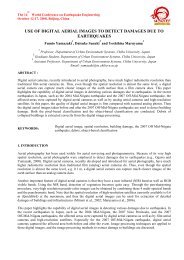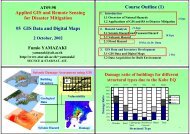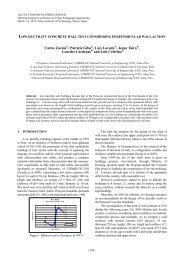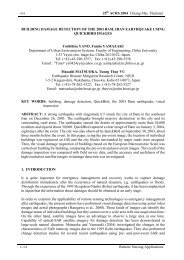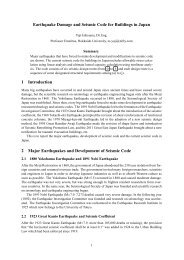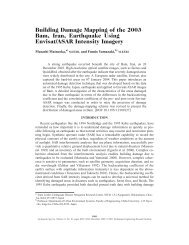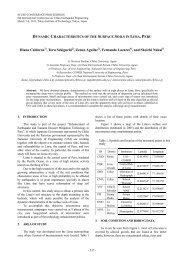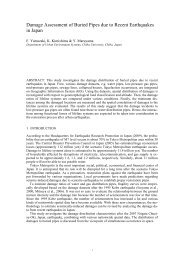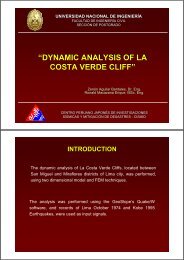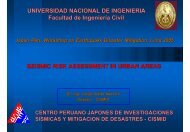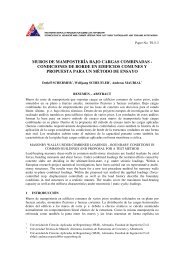Miguel A. Diaz , Koichi Kusunoki , and Akira Tasai
Miguel A. Diaz , Koichi Kusunoki , and Akira Tasai
Miguel A. Diaz , Koichi Kusunoki , and Akira Tasai
You also want an ePaper? Increase the reach of your titles
YUMPU automatically turns print PDFs into web optimized ePapers that Google loves.
Table 1 Characteristics of specimens<br />
Specimen<br />
Thickness<br />
1 st F<br />
column<br />
(mm)<br />
Height<br />
1 st F<br />
(mm)<br />
Total<br />
weight<br />
(kN)<br />
Natural<br />
period<br />
(s)<br />
Yield.<br />
Disp.<br />
(mm)<br />
Frame1 a 4.5 805 1.450 1.03 66<br />
Frame2 a, b 4.5 1005 1.464 1.66 101<br />
S-F 01, 02, 03 6.0 1000 1.485 0.93 71<br />
S-S 01, 02 6.0 1000 1.485 0.99 73<br />
S-S 03, 04 6.0 1000 1.485 0.98 73<br />
a) Velocity response spectra<br />
The measurement system was given by accelerometers<br />
at the base <strong>and</strong> beams of each level, <strong>and</strong> displacement<br />
transducers connected at each eastern rigid joint, as shown in<br />
Figure 3.<br />
3.2 Input waveforms<br />
The input motions to conduct this study were one<br />
artificial wave: the WG60, <strong>and</strong> two earthquake records: the<br />
KOBE-NS (Kobe, 1995) <strong>and</strong> the MYG013 (Tohoku, 2011).<br />
The input motions were scaled in order to induce different<br />
performance levels on the specimen within elastic <strong>and</strong><br />
inelastic ranges, both mainshocks <strong>and</strong> aftershocks. Figure 4<br />
shows the WG60, the KOBE-NS <strong>and</strong> the MYG013<br />
waveforms.<br />
b) Displacement <strong>and</strong> acceleration response spectra<br />
Figure 5 Response spectra<br />
3.3 Equivalent SDOF<br />
In order to conduct the residual seismic performance<br />
analysis, it is necessary to transform the capacity curve of<br />
the specimen in terms of S a − S d relations.<br />
The probable value of the maximum response is usually<br />
given by the square root of the sum of square (SRSS) of the<br />
maximum modal response components. Then the maximum<br />
displacement at i-th story <strong>and</strong> the base shear force can be<br />
expressed approximately by Eq. (5) <strong>and</strong> Eq. (6) (Shibata,<br />
2010), respectively; where s S d , s S a is the spectral<br />
displacement <strong>and</strong> spectral acceleration for the s-th mode.<br />
The base shear force of N-DOF is given by Eq. (7).<br />
|δ i | max ≈ √∑<br />
N<br />
| s β ∙ s u i ∙ S d<br />
s | 2<br />
S=1 (5)<br />
Figure 4 Input waveforms<br />
Figure 5 shows their respective a) normalized velocity<br />
response spectra respect to the maximum spectral velocity,<br />
<strong>and</strong> b) normalized response spectra respect to peak ground<br />
acceleration (PGA) <strong>and</strong> maximum spectral displacement.<br />
The maximum spectral response with viscous damping ratio<br />
of 0.05 was obtained at periods of 1.27 seconds, 0.87<br />
seconds <strong>and</strong> 0.67 seconds for the WG60, the KOBE-NS <strong>and</strong><br />
the MYG013 waveforms, respectively (Figure 5a).<br />
N N<br />
S=1 i=1<br />
+ (6)<br />
Q ≈ √∑ *∑ m i ∙ s β ∙ s u i ∙ s S a<br />
N<br />
Q = ∑i=1 m i ∙ (ẍ i + ẍ g) (7)<br />
Particularly, the specimens can be assumed as 3-DOF<br />
systems. Their configuration allows that second <strong>and</strong> third<br />
participation factor can be neglected, <strong>and</strong> the first-mode<br />
distribution can be assumed as the unit { 1 u} ≈ *1+. Then<br />
Eq. (5) is rewritten as Eq. (8) to calculate the spectral<br />
acceleration, <strong>and</strong> Eq. (7) into Eq. (6) is rewritten as Eq. (9) to<br />
calculate the spectral displacement.<br />
- 1206 -





